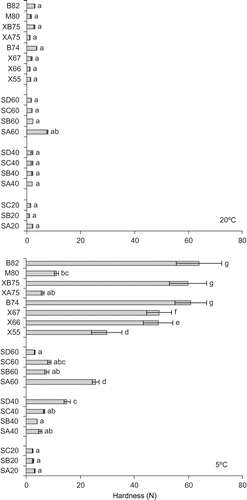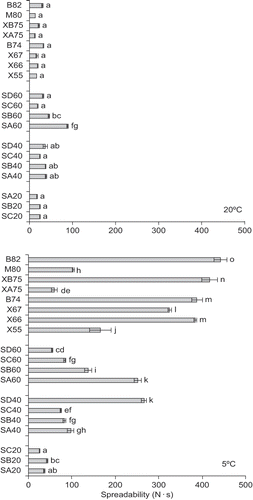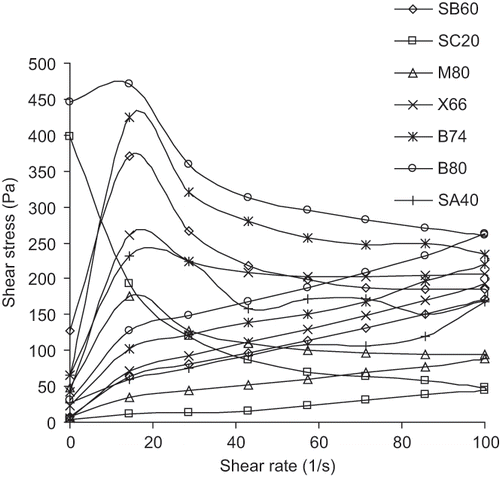Abstract
The rheological and instrumental textural properties of the butters, margarines and spreads were determined in this study. Three factors affected on the rheology and the instrumental texture of the examined yellow fat products: temperature of the measurement, origin and the content of the fat. The results obtained at 5 and 20° C showed significant differences (p ≤ 0.05) in spreadability and hardness. The highest hardness and the lowest spreadability values were recorded for the butters and mixed fat products with high fat content. Generally, milk fat content caused a significant increase of hardness and decrease of spreadability. The best spreadability was measured for the spreads with the lowest fat content. Adhesiveness and cohesiveness analysis revealed that the most adhesive and less cohesive were the products with high fat content, less adhesive and the most cohesive were spreads with the lowest content of lipids. All of the samples exhibited thixotropic and shear-thinning behavior. High correlation was found between spreadability and hardness. Apparent viscosity did not correlate with spreadability and hardness.
Keywords:
INTRODUCTION
Hardness and spreadability are the most essential features perceived by the consumers.[Citation1] The hardness and spreadability of the butters, margarines and spreads are mainly influenced by its ingredients, especially solid fat content.[Citation2] Increasing solid fat content causes an increase in hardness and decrease in spreadability. The melting temperatures of triacylglycerols depend on their chemical, often multiple, composition. Milk fat, for example, contains potentially thousands of different triacylglycerol species with melting temperature between −40°C and 40°C.[Citation3]
After 1980 world consumption of butter and margarine declined in favor of products with lower fat content.[Citation4] Over last decade, however, world butter consumption steadily inclines, margarines and spreads are more frequently chosen by the consumers.[Citation5] This is mainly due to the nutritional propaganda, the change of price ratios, the functional characteristics and the inferior cold spreadability of butter compared to margarine.[Citation6, Citation7]
There are many methods applied for spreadability evaluation. Apart from instrumental methods sensory analysis of hardness and spreadability is often applied and highly correlated with them.[Citation8, Citation9,Citation10] Most of the instrumental methods involve large deformations which break down the material's structure like penetrometry, extrusion, compression and sectility.[Citation3] Small deformation methods are also applied.[Citation11, Citation12,Citation13]
In this study cone penetrometry was used. Most of the original penetrometers were designed to fall under the constant load of the penetrating body.[Citation3] This method is recommended by American Oil Chemists Society.[Citation14] In this study the constant speed penetrometry is applied in which the penetrating body is mechanically driven into a sample at a constant speed and the force required to do so. The aim of this study was to evaluate instrumental texture and rheological characteristics of yellow fat products designed for spreading and to determine correlation between the measured parameters.
MATERIALS AND METHODS
Nineteen commercial table fats collected from different producers were used in this study. The specification of these products is given in .
Table 1 Specification of the examined table fats
Rheological Measurements
The flow curves and apparent viscosity were determined using Haake RS 300 rheometer (Haake, Karlsruhe, Germany) equipped with a concentric cone (35 mm diameter, 2° angle) and plate geometry. When the sample was placed on the plate, the lift moved and the cone took the measuring position (0.105 mm gap). Temperature control was maintained by a Haake DC30 circulator water bath (Haake GmbH, Karlsruhe, Germany). In a shear stress vs. shear rate measurement shear rate was changed every 2 min from 0.1 to 100 (s−1) linearly in eight steps and from 100 to 0.1 s−1 also linearly in eight steps. The apparent viscosity was measured at 20 s−1 shear rate for 120 s. For analytical purposes, the average value was calculated from 90th, 105th, and 120th second of the measurement.
Instrumental Texture
Samples of the table fats (40 cm3) at temperature 20°C were put into cylindrical plastic containers (40 mm in diameter) with special attention to avoid bubbles formation. Half of these containers was taken for analysis at once, the other half was stored at 5°C for 21 hours and the texture was analyzed immediately after this storage. The instrumental texture analyses were performed according to TPA method modified by Bonczar et al. [Citation16] by two sequential compression events at the crosshead speed 1 mm/s on 15 mm depth, separated by a relaxation phase of 15 s using a TA-XT2i texture analyser (Stable Microsystems, Godalming, England) equipped with a cylinder probe (1 cm diameter). The hardness, fracturability, springiness, adhesiveness, cohesiveness, gumminess, resilience and chewiness were investigated, however, only hardness, adhesiveness, and cohesiveness were used for the purpose of this study because fracturability, springiness, gumminess, resilience, and chewiness play inessential role in table fat texture estimation. The hardness is defined as force, which is necessary for obtaining the precise probe deformation. Adhesiveness is work necessary for overcoming the force of attraction between the area of foodstuff and other solids coming into contact with them. Cohesiveness is defined as forces of internal bonds, which keep the product as a whole.[Citation17]
Six samples of each spread, butter or margarine were evaluated per treatment. Each treatment was completed in triplicate.
Spreadability
Spreadability was measured using a TA-XT2 Texture Analyzer with a TTC Spreadability Rig (HDP/SR) attachment (Texture Technologies Corp.). Samples were filled into a female cones (90° angle) with special attention to avoid bubbles formation, and identically as it was carried out for the texture analysis procedure: half of the female cones was taken for analysis at once and the other half was stored at 5°C for 21 h and the spreadability was analyzed immediately after this storage. During the analysis samples were displaced to within 0.5 mm of the base of the female cone using a corresponding male cone (90° angle) attachment for the texture analyzer. Force expressed in Newtons was measured for the duration of the test, and spreadability was equated to the area under the curve. As more easily spreading samples required smaller forces to be displaced from the female cone, smaller values reflected easier spreadability.[Citation18] Four samples of each spread, butter or margarine were evaluated per treatment. Each treatment was completed in triplicate.
Statistical Analysis
The data were analysed using analysis of variance and Student's t-test by the Stat 1 (version 88) computer program (ISK, Skierniewice, Poland).
RESULTS AND DISCUSSION
The hardness was measured in two temperatures (). The differences in hardness values between examined products at 20°C were not significantly (p ≤ 0.05) important. Samples SD 40 and SA60 were significantly harder at low temperature. The higher hardness of these products was probably caused by the chemical composition. In the case of SD 40, the fat was the milk origin and the SA 60 spread was packed in the bar, so it suggests that it contained more hydrogenated oil. High hardness values were also recorded for the butters samples and most of the mixed fat products contained above 60% fat. The hardest of them were butters B82, B74 and amongst the mixed fat products, XB75.
The textural properties of butter and milkfat are the result of the 3-dimensional network of fat crystals associated with a continuous oil phase.[Citation19] Fat crystal networks are held together by van der Waals forces.[Citation3] The ratio of solid to liquid fat, is the primary determinant of butter consistency.[Citation20] The solid fat content (SFC) for butter is higher than in the butter-like products and commercial margarines[Citation9] and typical SFC curves for the tube and bar margarines indicate much lower SFC in the tub margarines. However, samples having similar SFC may exhibit different hardness values.[Citation21] This is because the strength of crystal network depends not only on the amount of solids present (% SFC) but also on the polymorphic behavior and the crystal size formed.[Citation22]
The differences in spreadability measured at 20°C and as for the hardness results in the most samples were not significantly (p ≤ 0.05) important (). The important differences in spreadability were observed when the samples temperature during the measurement was 5°C. The worst spreadability exhibited the butters and mixed fat products due to high content of fat and the presence of milk fat. The best spreadability was represented by the spreads with the lowest fat content.
Adhesiveness and cohesiveness analysis revealed significant differences (p ≤ 0.05) between the yellow fat samples at 5°C (). The most adhesive sample was SA60, the less adhesive were the spreads with the lowest fat content. The most cohesive were the samples with the 20% fat content. Increasing of the fat content, especially milk origin, caused significant decrease in cohesiveness.
Table 2 Table fats' values of cohesiveness, apparent viscosity, and adhesiveness
Apparent viscosity during the measurement was decreasing (data not shown) what suggests thixotropic behavior of the analyzed samples. All analysed samples were shear-thinned (pseudoplastic) () that is in agreement with previous findings.[Citation23, Citation24] contains correlation coefficients for different instrumental texture parameters at different temperatures. The correlation between spreadability and hardness is high especially at 5°C. Spreadability and cohesiveness measured at 5°C also correlate very well, however spreadability and adhesiveness at 5°C are not very well correlated. Low correlation coefficient between spreadability at 20°C and spreadability at 5°C as well as between hardness at 20°C and hardness at 5°C demonstrate very clearly differences in rheological properties of table fats at different temperatures. This is confirmed also by low correlation coefficients between spreadability at 5°C and apparent viscosity at 20°C, and hardness at 5°C and apparent viscosity at 20°C. Rousseau and Marangoni[Citation11] demonstrated that SFC and hardness of the butterfat and butterfat blends are considerably higher at 5°C than at 20°C.
Table 3 Values of correlation coefficients
High correlation is observed between hardness and cohesiveness. Apparent viscosity and spreadability are not very high correlated, as well as apparent viscosity and hardness. Mortensen and Danmark[Citation25] examining the consistency characteristics of butter also found that correlation between viscosity and spreadability is not very remarkable.
CONCLUSIONS
Three factors affected the rheology and the texture of the examined butters, margarines and spreads, i.e. temperature of the measurement, origin and content of the fat. The differences in hardness of the examined products at 20°C were not significantly (p ≤ 0.05) important. The samples contained more hydrogenated oil or milk fat were significantly harder at 5°C. The highest values of hardness were recorded for the butters samples and most of the mixed fat products contained above 60% fat. Adhesiveness and cohesiveness analysis revealed that the most adhesive and less cohesive were the products with high fat content, less adhesive and the most cohesive were spreads with the lowest content of lipids. All the samples exhibited thixotropic and shear-thinning behavior. High correlation was found between spreadability and hardness. Apparent viscosity did not correlate with spreadability and hardness.
REFERENCES
- Prentice , J.H. 1972 . Rheology and texture of dairy products . Journal of Texture Studies , 3 : 415 – 458 .
- Fearon , A.M. 2001 . Optimising milkfat composition and processing properties . Australian Journal of Dairy Technology , 2 : 104 – 108 .
- Wright , A.J. , Scanlon , M.G. , Hartel , R.W. and Marangoni , A.G. 2001 . Rheological properties of milkfat and butter . Journal of Food Science , 66 : 1056 – 1071 .
- Francis , F.J. 1999 . Wiley Encyclopedia of Food Science and Technology , 2nd , Vol. 1–4 , 218 John Wiley & Sons .
- Brown, S. What's in Store for Dairy Markets in the Coming Years? Dairy Forum 2006, January 15–18, 2006, La Quinta Resort & Spa La Quinta, CA http://www.fapri.missouri.edu/outreach/presentations/2006/IDFA2006SB.pdf
- Schaffer , B. , Szakaly , S. , Lorinczy , D. and Schaffer , B. 2001 . Melting properties of butter fat and the consistency of butter. Effect of modification of cream ripening and fatty acid composition . Journal of Thermal Analysis Calorimetry , 64 : 659 – 669 .
- Uprit , S. and Mishra , H.N. 2004 . Instrumental textural profile analysis of soy fortified pressed chilled acid coagulated curd (paneer). . International Journal of Food Properties , 7 ( 3 ) : 367 – 378 .
- Rousseau , D. and Marangoni , A.G. 1999 . The effects of interesterification on physical and sensory attributes of butterfat and butterfat-canola oil spreads . Food Research International , 31 : 381 – 388 .
- Staniewski , B. , Szpendowski , J. , Panfil-Kuncewicz , H. , Malkus , J. and Bohdziewicz , K. 2006 . The application of an AP4/2 conical penetrometer for the evaluation of spreadability of selected table fats . Milchwissenschaft , 61 : 292 – 296 .
- Rohm , H. , Strobl , M. and Jaros , D. 1997 . Butter colour affects sensory perception of spreadability . Zeitschrift fur Lebensmitteluntersuchung und Forschung A - Food Research and Technology , 205 : 108 – 110 .
- Rousseau , D. and Marangoni , A.G. 1998 . Tailoring the textural attributes of butter fat/canola oil blends via Rhizopus arrhizus lipase-catalyzed interesterification. 2. Modifications of physical properties . Journal of Agricultural and Food Chemistry , 46 : 2375 – 2381 .
- Brunello , N. , McGauley , S.E and Marangoni , A. 2003 . Mechanical properties of cocoa butter in relation to its crystallization behavior and microstructure . Lebensmittel-Wissenschaft und Technologie , 36 : 525 – 532 .
- Rohm , H. and Weidinger , K.H. 1993 . Rheological behaviour of butter at small deformations . Journal of Texture Studies , 24 : 157 – 172 .
- American Oil Chemists' Society . 1989 . Method Cc.16–60. Official and tentative methods: additions and revisions , Champain, IL : AOCS Press .
- Bylund , G. 1995 . Dairy processing handbook , 264 Lund, Sweden : Tetra Pak Processing Systems AB .
- Bonczar , G. , Wszolek , M. and Siuta , A. 2002 . The effects of certain factors on the properties of yoghurt made from ewe's milk . Food Chemistry , 79 : 85 – 91 .
- Domagala , J. , Sady , M. , Grega , T. and Bonczar , G. 2006 . Rheological properties and texture of yoghurts when oat-maltodextrin is used as a fat substitute . International Journal of Food Properties , 9 ( 1 ) : 1 – 11 .
- Swenson , B.J. , Wendorff , W.L. and Lindsay , R.C. 2000 . Effects of ingredients on the functionality of fat-free process cheese spreads . 65 ( 5 ) : 822 – 825 .
- de Man , J.M. and Beers , A.M. 1987 . Review: Fat crystal networks: Structure and rheological properties . Journal of Texture Studies , 18 : 303 – 318 .
- Rohm , H. and Weidinger , K.H. 1993 . Rheological behaviour of butter at small deformations . Journal of Texture Studies , 24 : 157 – 172 .
- Laia , O.M. , Ghazalia , H.M. , Cho , France and Chong , C.L. 2000 . Physical and textural properties of an experimental table margarine prepared from lipase-catalysed transesterified palm stearin: palm kernel olein mixture during storage . Food Chemistry , 71 : 173 – 179 .
- de Man , L. , de Man , J. M. and Blackman , B. 1989 . Polymorphic behaviour of some fully hydrogenated oils and their mixtures with liquid canola oil . Journal of the American Oil Chemists Society , 66 : 1777 – 1782 .
- Lai , O.M. , Ghazalia , H.M. and France Cho; Chong , C.L. 1999 . Flow properties of table margarine prepared from lipase-catalysed transesterified palm stearin: palm kernel olein feedstock . Food Chemistry , 64 : 221 – 226 .
- Lee , B.Y. , Kim , D.M. and Kim , K.H. 1991 . Measurement of the viscosity of semi-solid foods with an extrusion capillary viscometer. Journal of the Korean Society of Food and Nutrition . 20 ( 5 ) : 509 – 512 .
- Mortensen , B.K. and Danmark , H. 1982 . Consistency characteristics of butter . Milchwissenschaft , 37 : 530 – 532 .


